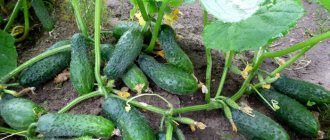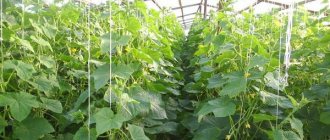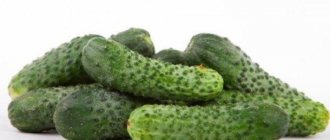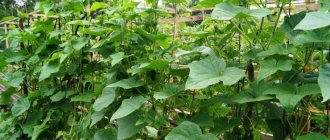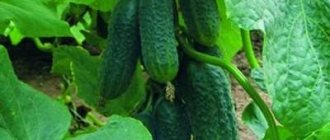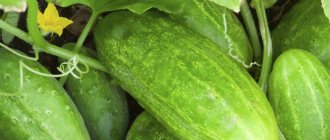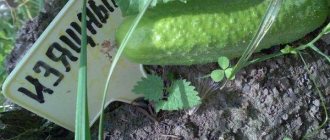Cucumber varieties for Siberia
Breeders have developed a large number of varieties. They all differ in the speed of ripening, resistance to disease or adaptability to certain climatic conditions. To obtain a stable harvest, cucumber seeds for Siberia must meet the following requirements:
- short ripening times - short summer does not allow growing late varieties;
- frost resistance - the crop must withstand sudden cold snaps at night;
- heat resistance - few people know, but in Siberia they often record abnormal heat, over 35 degrees.
The resistance of a crop to unfavorable conditions is the key to obtaining a high yield. In the region, prolonged rains are easily replaced by heat within a short period of time. In unfavorable weather, insects do not pollinate plants. Therefore, in most cases, it is recommended to choose self-pollinating cucumber varieties for Siberia.
According to ripening period
In Siberia, it is advisable to grow only early and mid-season cucumbers. The most recommended early varieties include:
- F1 Herman - the fruits are small in size, from 10 to 11 cm. The growing season is 35–45 days;
- Altai gherkin is a universal variety. Ripening time is from 38 to 50 days. Resistant to low temperatures;
- Altai - Early ripening, bee-pollinated, salad. Growing season – 35–38 days;
- Alliance – Fruiting begins on days 51-54.
- April - begins to bear fruit in 40–45 days;
- Graceful - has been in the register of breeding achievements since 1971. Ripening time: 40–45 days;
- Muromsky 36 – the harvest period begins from 32–42 days;
- Summer resident – 35–45 days.
Altai gherkin.
Popular mid-season cucumbers include:
- Brigantine;
- Competitor;
- Raphael;
- Firefly;
- Gusto;
- Steppe;
- Topolek;
- Champion.
The average ripening time for these varieties ranges from 45 to 55 days .
Competitor.
Champion.
By yield
The yield of a crop depends not only on the climate, but also on the resources put into the variety by the breeders. The most productive cucumbers for Siberia have the following characteristics:
- F1 Herman – yield 8.5–9.0 kg/m2;
- Altai – 3.6–3.8 kg/2;
- Altai gherkin – 11.3–12.1 kg/2;
- Alliance - in the East Siberian region - 6.4 kg/2;
- Brigantine – marketable yield 158–489 c/ha;
- Summer resident - marketable yield in a film unheated greenhouse is 13.2 kg/2;
- Rafael – 20.9–24.5 kg/2;
- Firefly - in the Ural region - 118-329 c/ha;
- Smak – 260–453 c/ha;
- Steppe – 176–406 c/ha;
- Champion is a high-yielding variety. The average yield is 270–467 c/ha.
Depending on climatic conditions and plant care, yields may vary.
By cooking method
Having opened a jar of preserves, many are left disappointed. Pickled or pickled cucumbers are empty inside, do not crunch, and the taste leaves much to be desired. The fact is that not all cucumbers are suitable for making cold appetizers. When choosing seeds, you need to pay attention to their brand. Varieties are divided into:
- salad - used for preparing salads or eating fresh;
- canning - suitable for canning. Pickled and pickled cucumbers turn out crispy and do not lose their taste during long-term storage;
- universal – can be used both for making fresh dishes and for canning;
- pickling - best suited for making pickles.
Salad types include :
- Altai gherkin;
- Alliance is a universal hybrid;
- Summer resident;
- Raphael is universal;
- Elegant.
Recommended varieties for preservation are:
- F1 Herman;
- Altai - best suited for pickling;
- Brigantine - also refers to pickling varieties;
- Firefly;
- Gusto;
- Steppe;
- Champion;
- Muromsky 36.
Each gardener decides for himself which hybrid and for what purposes it is necessary to sow.
For open ground
The difference in using seeds for greenhouses and open ground lies not only in the timing of ripening or sensitivity to temperature conditions, but also in the method of pollination of plants. Varieties are divided into:
- pollinated by insects;
- self-pollinating or parthenocarpic.
Varieties resistant to diseases
Elegant
Bee-pollinated variety of early ripening. Fruits with small tubercles grow up to 10-12 cm and gain a weight of about 130 g. On the 45th day after sprouts appear from the seeds, you can look for ripe fruits on the bushes. Not susceptible to pumpkin diseases. Resistant to weather changes. Each bush forms 5-6 lashes, so pinching is required. Gives a small harvest - up to 7 kg of vegetables per 1 m².
Baby crane F1
Early ripening hybrid. Not susceptible to pumpkin diseases. On the 45th day after sprouts appear from the seeds, you can look for ripe fruits on the bushes. Cucumbers are without bitterness and grow 10-12 cm in length. Universal in use.
Topolek F1
Looks like a hybrid Crane. It tolerates cold weather well and is not susceptible to pumpkin diseases. Cucumbers grow 11-14 cm in length. If agricultural practices are violated, the skin becomes slightly bitter.
Altai
Popular early ripening variety. Bee pollinated. On days 36-38 after sprouts appear from the seeds, you can look for ripe fruits on the bushes. Suitable for cultivation in open and closed ground. Shows good immunity to pumpkin diseases. The skin is pimply. The fruits grow up to 10 cm in length and are suitable for pickling and canning.
Cascade
Mid-season variety. On the 50th day after sprouts appear from the seeds, you can look for ripe fruits on the bushes. Not afraid of fungal and bacterial diseases. Forms mainly female flowers. The fruits ripen at the same time. Dark green cucumbers grow up to 15 cm in length and gain weight of no more than 100 g. From 1 m2 you get 8 kg of vegetables.
Hermann
The most resistant parthenocarpic hybrid to pumpkin diseases. The fruits ripen early. The ovaries are formed in bunches. About 6 fruits can be formed in one bunch. The cucumber grows no more than 12 cm in length and resembles a gherkin. The taste is sweet, without bitterness. The fruits are universal in use.
Soil preparation
In cold climates, it is recommended to grow cucumbers in so-called raised beds. Waiting for the soil to completely thaw and warm up in the spring is a waste of precious time. To speed up this process, you must use the following method:
- at the site where the cucumber bed is organized, the top layer of soil 10 cm deep should be removed;
- remove all weeds, roots and insect larvae from the removed soil;
- a fence 15-20 cm high is made around the perimeter of the bed from boards or other material that will hold the ground;
- half of the extracted soil should be mixed with sawdust, hay or foliage in a ratio of 50 to 50 and covered with an even layer;
- the second half must be mixed with peat (in the same proportions), rotted manure added and distributed over the bed in an even layer;
- To better warm the soil, the top of the bed is covered with plastic film, preferably black.
Cucumbers develop well in loose, well-oxygenated soil. If there is an excess of moisture, the root system of the crop begins to rot and fungal diseases develop, which reduces the yield.
Differences between Siberian selection: pros and cons
Cucumber is a crop that loves warmth, a lot of light and cannot tolerate lack of moisture. But breeders are tirelessly working to develop new varieties that bear fruit well in the soil, greenhouse or greenhouse under the conditions of the short and cold Siberian summer. The seeds of these crops are characterized by increased resistance to temperature fluctuations, do not shed the ovary, and have strong immunity. Most of the productive varieties do not require pollination by bees, which is also a definite plus. Breeders develop early and mid-ripening varieties. Thanks to this, the crop is harvested already in the first half of summer. Despite these advantages, a number of conditions must be met for abundant fruiting:
- The average daily air temperature should not fall below +14 °C.
- A poorly developed root system requires meticulous care; when transplanting seedlings, all actions are performed carefully.
- Monitor the acidity of the soil, which should not be higher than 5.6 pH;
- Do not plant seedlings in clay soil. In it, plants develop poorly and the level of fruiting decreases.
- Regular feeding.
- For better fruiting, preference is given to varieties with female flowering. As you can see from the photo, such greens produce 5-7 fruits in one ovary.
If not all the seeds are useful during sowing, in order to preserve their germination properties, they are stored correctly. Paper bags are best. To prevent rodents from getting to the seeds, they are placed in a tin container, having previously made holes for ventilation. The optimal temperature for seeds to germinate is considered to be +15 °C.
Important!
Under no circumstances should unvented containers be used. The seeds will become damp and lose their germination properties.
Seed preparation
When using purchased seed material, pre-preparation is not necessary. In agricultural firms, all the necessary manipulations, as a rule, have already been carried out. That is why seeds can be colored in different, unnatural colors. However, if you prepared the seed material yourself, then they should be pre-treated before planting. For this:
- sort - remove damaged copies;
- place the seeds in a glass of water, collect the floating ones and also dispose of them - this is empty seed material;
- to prevent fungal diseases, soak the seeds in any pesticide for 3–6 hours;
- For the same purposes, you can use a solution: boric acid, copper sulfate or a weak solution of potassium permanganate for 12 hours.
Attention! Most cucumbers purchased are hybrids and are labeled F1. This means that it is not possible to obtain seed material from them again.
Greenhouses:
- Zozulya F1 - greenhouses and temporary shelters (“Siberian Garden”).
- Claudia F1 - for closed ground (film and glazed greenhouses) (Seeds of Altai).
- Button F1 - greenhouses and temporary film shelters (“Siberian Garden”).
- April F1 - indoor ground (“Siberian Garden”).
- Daring fellow F1 - spring-summer greenhouses and various temporary shelters (“Siberian Garden”).
- Jade F1 - glass and film greenhouses (“Siberian Garden”).
- Orpheus - film greenhouses and other types of shelters (“Siberian Garden”).
- Bidretta - glazed or film greenhouses, tunnels (“Siberian Garden”).
- Zadavaka F1 - greenhouses and film shelters (“Siberian Garden”).
Landing
Planting cucumbers can be done in two ways:
- seeds;
- seedlings.
Despite the short summer in Siberia, both methods are suitable .
Landing scheme.
When to plant
The most optimal time for planting a crop is the period when the threat of frost has passed - at the end of April or beginning of May . The suitable temperature for plant development is +21 – +25°C during the daytime and not lower than + 15°C at night.
Night temperatures below +8°C can negatively affect crop yields or even destroy crops. To prevent plants from overcooling, it is recommended to cover the beds with film or mulch.
Attention! If the seedling sowing method was chosen, then the seedlings begin to be planted in separate containers or cups 2-3 weeks before planting in the ground.
The nuances of planting in open ground
Growing crops in open ground and in a greenhouse are somewhat different. The main differences include:
- in open beds you can use both self-pollinating and insect-pollinated varieties;
- the temperature at which plants should be planted should not be lower than +18°C during the daytime;
- the distance between rows is 50–60 cm, between plants – 40-50 cm;
- seed placement depth is 2–3 cm.
Planting plants in open ground and in a greenhouse
For the Siberian region, it is important to choose the optimal planting time so as not to freeze the seedlings and at the same time ensure the required growing season. The short summer does not allow the cultivation of late-ripening species.
Let us highlight the main conditions for the successful growth of cucumbers:
- the average daily temperature should be above 15 °;
- soil acidity – above pH 5.6;
- heavy loamy soils slow down the growth of the green part and lead to rotting of the roots; the soil needs to be lightened with peat and sawdust;
- covering the soil with mulch, dark cloth or film warms the roots and improves vegetation.
At high humidity, the roots rot, the plant is affected by fungal infections, and the soil requires drainage.
Choosing varieties
Many summer residents prefer to choose varieties and hybrids of Siberian selection that are ideally adapted to the conditions. But you shouldn’t dwell on them only; you can also plant other varieties that have a short ripening time.
In terms of ripening time, two types are suitable - early and mid-ripening. Bush cucumbers are low-growing, many value them for their uniform yield and saving on acreage. Parthenocarpic species are popular in Siberia, as they bear fruit well in greenhouses. In cold conditions and a small number of bees, they perfectly form ovaries in open ground.
Most summer residents plant 3-4 varieties, annually replacing 1 usual variety with a new hybrid.
Preparing the seeds
You should buy seeds from trusted producers. Most popular cucumbers are hybrids; you won’t be able to obtain seed material yourself. You have to rely on seed companies.
Before planting, the seeds are sorted, damaged, chipped, small and differing in appearance from the main mass are discarded.
Germination is checked in a glass of salted water; empty ones float to the surface. For Siberia, hardening is also usually carried out. Before planting, the seeds are disinfected in a bright solution of potassium permanganate.
Sowing patterns and technology
It is recommended to grow cucumbers in open ground in high beds. The earth takes a long time to warm up; waiting until it completely thaws will waste time. The top layer is removed from the soil, the removed soil is cleaned of roots, weeds, and larvae.
The walls to hold the soil are made of boards, and a layer of soil mixed with sawdust, leaves, tops, pine branches, and hay is added. The removed soil, lightened with peat, is returned to this embankment. The prepared bed is covered with a dark cloth to warm it up. They also prepare the soil for planting seedlings in the greenhouse.
The best planting method for Siberia is to prepare seedlings. The plant begins to develop in warmth and comfort, strengthens, and increases the green part. The initial stage of development does not depend on weather disasters.
See also
TOP 30 best varieties of cold-resistant cucumbers with descriptions and characteristics
Read
The beds are made single-row or double-row. The distance between the holes depends on the size of the bush and is 35-50 centimeters. When planting in two rows, the distance between paired rows is 50-60 centimeters. The row spacing is 80-90 centimeters.
With a horizontal bed, that is, growing in a lying position, you need to provide space for the stems, which weave, branch and occupy a large area. When tying to trellises, you need to prepare the material for their construction in advance.
Terms and rules for planting seedlings
For seedlings, containers with fertile soil are prepared, the seeds are germinated in damp cloth or planted dry. The seed is buried 2-3 centimeters into the ground, watered and covered with insulating film.
Planting in heated polycarbonate greenhouses is carried out in mid-April. Cucumbers should be planted in open ground after May 15, when the danger of severe frosts has passed. The most productive way to get a quick harvest in open ground is to install arcs and cover the beds with film to provide constant warmth to the plants.
Important: the area for planting cucumbers must be changed regularly; the best crops that grow into greens are tomatoes, legumes, and cabbage.
Care
The plant should be cared for throughout the season. It is necessary to feed, water on time and ensure that fungal diseases do not begin to develop on the plants. Only by following all agrotechnical rules can a good harvest be achieved.
Watering
Cucumbers do not tolerate both a lack of moisture (after all, this is a tropical plant) and its excess. At first, it is enough to water the plants 3 times a week. After the first fruits appear, watering should be daily.
In rainy weather, the plants are not watered. During this period, it is only important to loosen the soil to avoid the development of rot.
Top dressing
The first feeding should be done after 2-3 weeks. Then the procedure is repeated every 10 days. It is recommended to alternate fertilizers each time: potassium, phosphorus, organic. An infusion of chicken manure or cow manure can be used as organic matter.
Weeding
Over the entire season, it is enough to carry out 3-4 weedings with an interval of 1.5 weeks. Removing weeds not only helps preserve nutrients for crops, but also prevents the development of diseases.
Treatment against insects and diseases
In order to prevent fungal diseases from developing and prevent the activity of insect pests, 3 preventive treatments should be carried out throughout the entire season. The first treatment is carried out after 2 weeks, subsequent ones - after 10 days.
To do this, it is necessary to use fungicides and insecticides according to the manufacturer's instructions. Resistance to disease is also increased by growth stimulants.
Nuances of cultivation
Growing cucumbers in a greenhouse and in open ground have their own characteristics.
In the open ground
In the cold and unpredictable climate of Siberia, the following features must be taken into account:
- the summer resident should cover the beds with film or other covering material every day for the first 1–2 weeks;
- in open beds, the horizontal or bunch growing method is mainly used. Therefore, the distance between plants should be at least 40 cm.
During prolonged rains, plants must also be covered with film to avoid excess moisture in the ground.
In the greenhouse
In greenhouses, to save space, a vertical method of growing cucumbers is used. For this purpose, ropes, nets or trellises are used to tie up plants. Therefore, you can plant cucumbers in greenhouses at a much smaller distance from each other.
Growing on a grid.
Also, due to saving space in the greenhouse, it is recommended to plant low-growing rather than tall hybrids of cucumbers - the current level of selection provides a large selection of varieties.
Inside the greenhouse there is its own closed microclimate. Precipitation from the external environment does not penetrate there, so the summer resident needs to devote much more time and attention to caring for the plants: watering, ventilation, etc.
A little more about Siberian families
To get a general picture of Siberian cucumber varieties, let's take a look at the popular families:
- Varieties of the "fruit" family usually have fruits 15 to 20 cm long with a smooth skin. They are used for salads, but some varieties can be lightly salted. Prominent representatives of this family: “Fruit F1”, “April F1”, “Gift F1”, “Spring whim F1”, etc.
- The “alligator” family is similar in yield to zucchini. Planting 5 bushes is enough for an average family. Cucumbers are also called Chinese and are most often used for salads, but lightly salted cucumbers are also possible. Bright representatives of the family: “Elizabeth F1”, “Alligator F1”, “Ekaterina F1”, “Beijing delicious F1”, etc.
- Varieties of the “albino” family grow well in the open ground of Siberia. The vegetable is unusually pale in color and has excellent taste. Sometimes the cucumber is called Japanese.
- Gherkins are an ideal option for preservation. The length of the fruit does not exceed 12 cm. Representatives of the family: “Gerda F1”, “Quartet F1”, “Boris F1”, “Friendly Family F1”, etc.
- German varieties are good for preservation. Their fruits are covered with pimples, between which there are thorns. When salting, salt penetrates into the pulp through damaged spines. Representatives of the family: “Zest F1”, “Bidretta F1”, “Diva F1”, “Libella F1”.
- Mini gherkins are created for real gourmets who love small pickled cucumbers. Pickles are preserved one-day old, up to 4 cm in size. Prominent representatives for Siberia: “Son of the Regiment F1”, “Boy Scout F1”, “Spring F1”, “Filippok F1”.
When to Harvest
The harvest begins as the fruits appear and reach a length of more than 5 cm. The fruits should be torn off carefully, trying not to damage the nearest leaves or shoots.
The collection lasts from 2 weeks to 1 month, depending on the variety. When harvesting cucumbers, you should also remove leaves and shoots affected by disease or insects. Avoid overripe fruits. Following these rules will allow you to get a good harvest even in the unstable climatic conditions of Siberia.
What's special about Siberian cucumbers
The average gardener will not see any major external differences in these vegetables. As they say, a cucumber is a cucumber in Africa, the same green fruit with a pimpled or smooth surface and a characteristic aroma. The peculiarity of the variety for Siberia is its endurance. Subtropical zones with a warm climate are considered the homeland of cucumbers. For many years, the culture roamed around the world, developing immunity to harsher weather conditions. Breeders made a great contribution to the survival rate of cucumbers.
The varieties for Siberia are mainly hybrids. Resistance to cold is genetically instilled in them. Breeders have taken all the best qualities of simple cucumbers, such as fertility, survival, disease resistance, self-pollination, and collected it all in one specific variety. This is how hybrids turned out. Without requiring the participation of bees, cucumber flowers self-pollinate, bringing good yields in the harsh climate of Siberia.
The variety of hybrids is great, however, numerous reviews on forums indicate a greater demand for early cucumbers. Such varieties are most often requested in seed stores. This is due to the fact that Siberia is characterized by a short summer and a vegetable planted in open ground must have time to bear fruit during this time.
One such example is the hybrid “Siberian Yard F1”. Cucumber seeds germinate quickly, allowing for an early harvest. The fruits are in demand for preservation due to the ability of the peel to absorb brine in parts. The pulp is salted evenly, giving the vegetable a pleasant taste.
If the open ground was infected last year with diseased cucumbers or an outbreak of the disease is observed in a neighboring area, it is better to plant the hybrid “Herman F1”. Its fruits are excellent for canning.
“Muromskie” cucumbers are ideal for the short summer of Siberia. The plant can be planted directly into the ground or greenhouse. In a maximum of a month and a half, the first early harvest will appear.
Important! You can distinguish hybrid seeds on the packaging by the designation “F1”. However, you need to know that they are suitable for one-time planting. You cannot independently collect seeds from ripe cucumbers for propagation. Plants grown from them will not produce a harvest.
